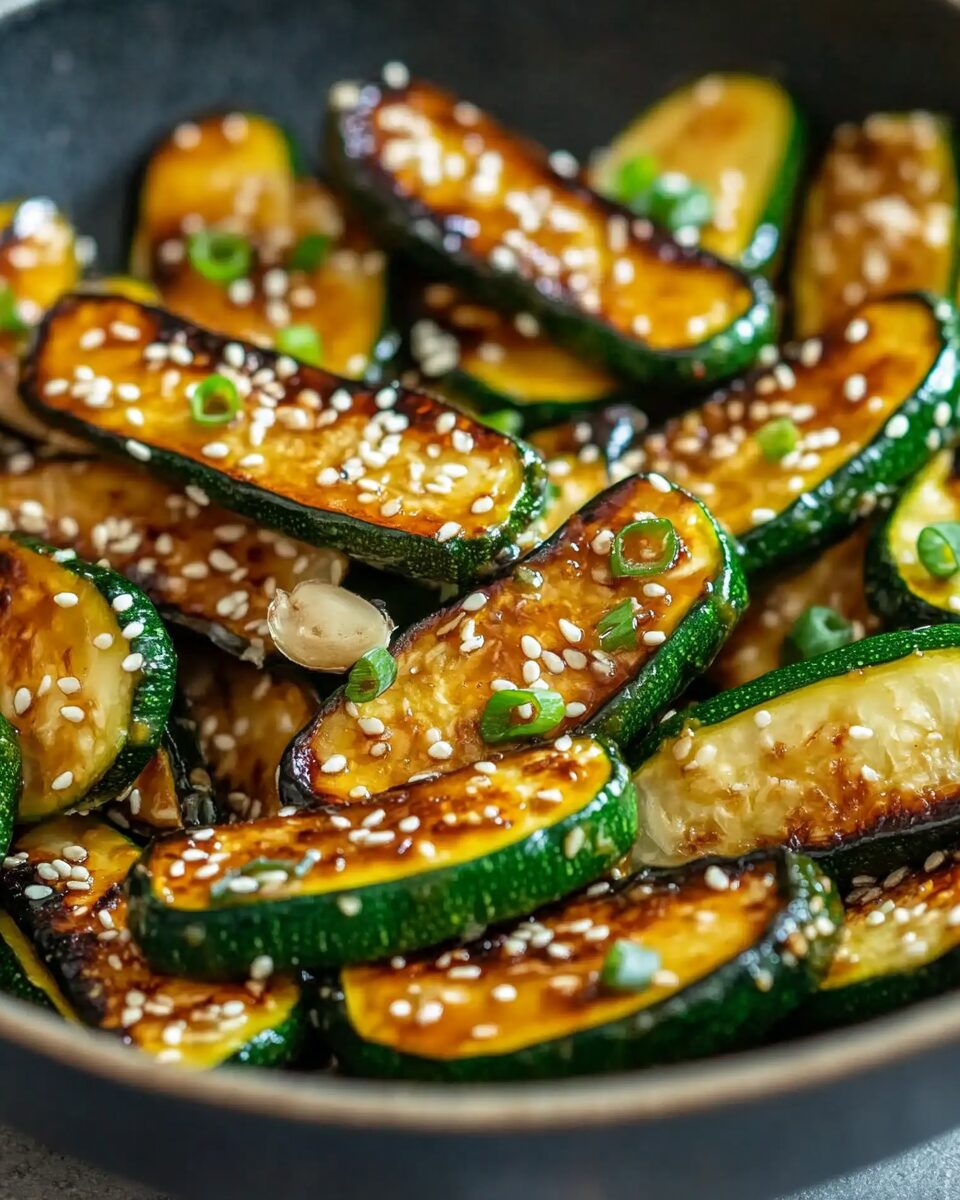The Magic Behind Hibachi Zucchini
The appeal of Hibachi Zucchini lies in its high-heat, quick-cook method that locks in the fresh, natural sweetness of the vegetables while developing deep, savory notes from the seasonings. The zucchini is cooked just long enough to achieve a slight char without losing its firm, juicy texture. Garlic and ginger add pungency and warmth, while soy sauce brings in a salty, savory depth that enhances the vegetable’s natural flavors. A dash of sesame oil imparts a toasted, nutty aroma that ties everything together, making the dish taste as though it came straight off a hot, sizzling hibachi grill. The addition of sesame seeds offers a delightful contrast of texture and flavor, completing the dish with a light crunch.
Why You’ll Love This Dish
Hibachi Zucchini is everything you want in a quick side dish: fast, flavorful, healthy, and incredibly versatile. It’s naturally gluten-free if tamari or a gluten-free soy sauce is used, and it’s suitable for low-carb, vegetarian, and even vegan diets. The dish requires minimal ingredients, most of which are pantry staples, and it cooks in under 10 minutes, making it ideal for busy weeknights. Its bold flavors pair well with a wide variety of main dishes, from grilled meats and seafood to stir-fries and fried rice. Plus, it’s a great way to use up summer zucchini when the garden is overflowing, turning a humble vegetable into a restaurant-quality side dish.
Tips for Making the Best Hibachi Zucchini
To achieve the best results, cook the zucchini over medium-high to high heat, ensuring a nice sear without making the vegetables soggy. Cut the zucchini into uniform sticks to ensure even cooking and a consistent texture. Preheat your pan until it’s shimmering hot before adding the oil to get that signature hibachi-style char. Stir the vegetables just enough to prevent burning but allow them to develop some color. Use a light hand when adding soy sauce and sesame oil—these ingredients are powerful and can easily overwhelm the delicate zucchini if overused. Garnish with a generous sprinkle of sesame seeds right before serving to maximize their nutty flavor and texture.
Common Mistakes to Avoid
One common mistake is overcrowding the pan, which steams the vegetables instead of searing them, resulting in a mushy texture. Always cook in batches if necessary to maintain high heat and proper caramelization. Another pitfall is cooking the zucchini for too long; overcooked zucchini becomes soft and watery, losing the signature tender-crisp texture that makes Hibachi Zucchini so delicious. Using too much oil can also cause the dish to become greasy rather than light and flavorful. Lastly, adding the soy sauce too early can lead to soggy vegetables—always add it toward the end of cooking for the best flavor and texture.
Serving Suggestions
Hibachi Zucchini shines as part of a full hibachi-style meal. Serve it alongside fried rice, teriyaki chicken, grilled shrimp, or seared steak for a complete restaurant-inspired experience at home. It also pairs beautifully with other Japanese-inspired dishes like miso soup, gyoza, or yakitori. For a lighter meal, serve it over steamed jasmine rice with a sprinkle of chopped green onions and a squeeze of fresh lime juice. If you’re planning a larger spread, Hibachi Zucchini can be part of a vegetable medley including carrots, mushrooms, and snap peas, all stir-fried in a similar style for a colorful, nutrient-packed platter.
Adaptations and Variations
Hibachi Zucchini is highly adaptable to different tastes and dietary needs. For a spicier version, add a pinch of red pepper flakes or a drizzle of sriracha at the end. If you prefer a sweeter touch, stir in a teaspoon of mirin or honey with the soy sauce. For a garlic-lover’s variation, double the amount of garlic or add roasted garlic for an even deeper flavor. Other vegetables like yellow squash, bell peppers, or broccoli can be added to the zucchini for a more robust veggie medley. If you want a heartier dish, toss in cubed tofu or thinly sliced beef for extra protein without straying from the hibachi flavor profile.
The Cultural Influence Behind Hibachi Cooking
Hibachi cooking, known for its hot iron griddles and skilled chefs performing elaborate cooking shows, is a popular style of Japanese-inspired dining, especially in the United States. While hibachi in Japan originally referred to a heating device, the Americanized version often blends elements of traditional teppanyaki-style cooking, where meats, seafood, and vegetables are quickly cooked over a high-heat flat top. Hibachi Zucchini captures the spirit of this experience—the sizzle, the speed, and the big flavors—in a simple side dish that you can easily replicate at home without any special equipment. It’s a reminder that great food doesn’t have to be complicated or require fancy techniques to be deeply satisfying and memorable.
Nutritional Information
Each serving of Hibachi Zucchini provides approximately 120 calories, making it a light yet satisfying side dish. It contains around 8 grams of carbohydrates, primarily from the zucchini and onions, offering a modest amount of energy without being heavy. The fat content, about 9 grams per serving, comes mostly from the vegetable oil and sesame oil, providing heart-healthy unsaturated fats. With 2 grams of protein and a good amount of dietary fiber, it supports satiety and digestive health. The dish is also rich in vitamins, particularly vitamin A and vitamin C, thanks to the zucchini and onions, offering antioxidant benefits that support immune function and skin health.
Conclusion
Hibachi Zucchini is the perfect example of how simple ingredients and quick cooking techniques can produce a dish that’s full of vibrant flavor and satisfying texture. With its tender-crisp zucchini, savory onions, aromatic garlic and ginger, and the rich umami notes from soy sauce and sesame oil, this side dish brings the excitement of a Japanese steakhouse right into your own kitchen. Versatile, easy, and delicious, Hibachi Zucchini is a fantastic way to elevate everyday meals or recreate an authentic hibachi experience at home. Once you taste the irresistible crunch and bold flavors, you’ll find yourself making this dish again and again for any occasion.






